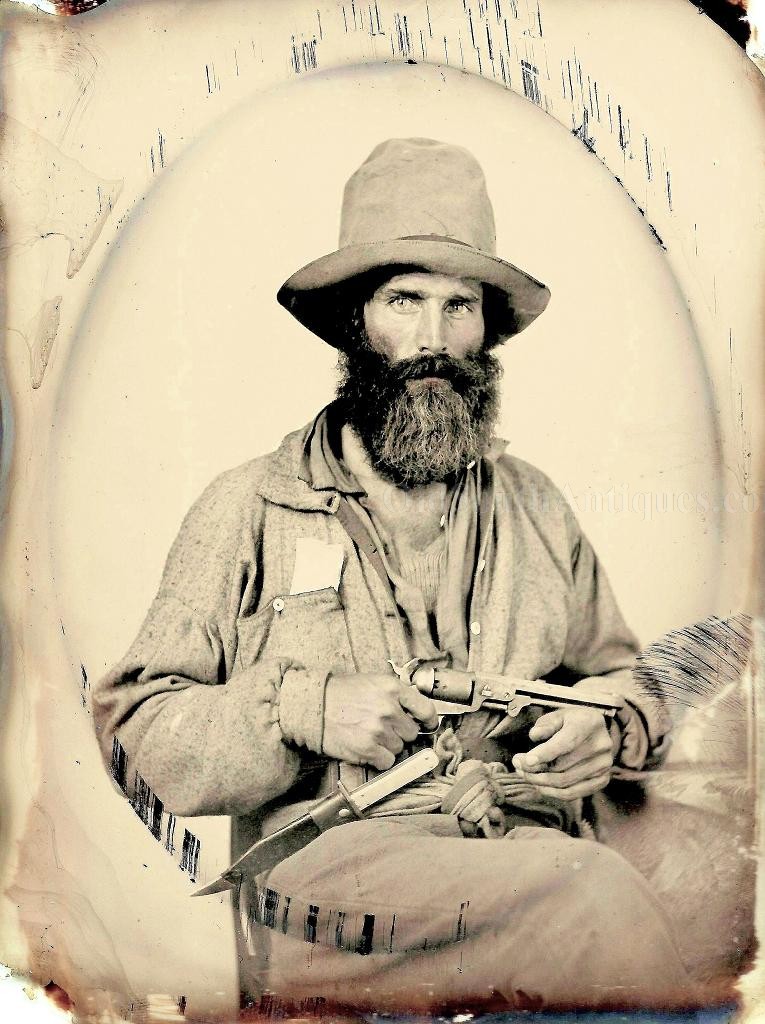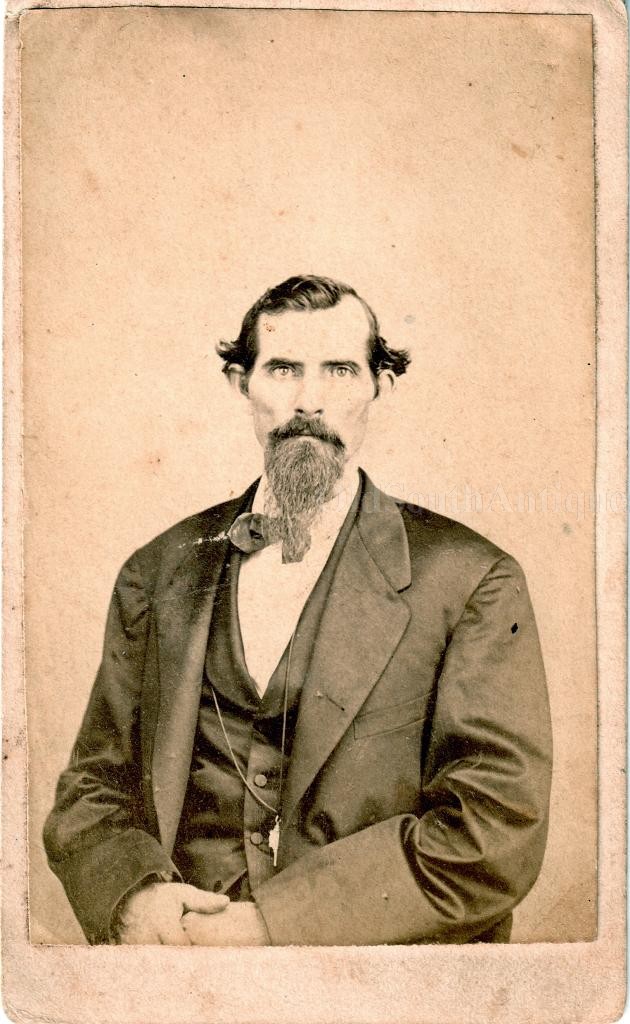
| Catalog | Past Items | Order Info | Terms/Conditions | About Us | Inventory Clearance |
Based on the information that I had at the time I first wrote about this image, I felt confident that he was a Texan. New information has come to light that leaves no doubt that he is indeed a Texan. The soldier’s fierce gaze is so very distinctive that when one of my readers saw him, he instantly recognized him as the same man that was the subject of a CDV, which is shown below, that had been handed down in his family. The back of the CDV is marked "SB Russell Texas”. Russell worked out of Navasota, Texas. This confirms my speculation. Though my reader did not know his ancestor’s name, he knew his family history and very kindly shared it with me.
He wrote: "My aunt died at 92 in 2012 and her family gave my cousin (not her son) a bunch of old pictures and he gave them all to me and the picture I sent you was among them. I had been impressed with the guy in my CDV because he looked like someone to not be messed with, so I was immediately taken when I saw your image. Thus he is very likely a Baird.”
"John Baird
came from Scotland to VA in the 1600s.
His son, John, was born in 1675 and he married Margaret Rookings in
1699, granddaughter of William Rookings, III, whose plantation was Flying Point
in Surry and who took part in Bacon’s Rebellion. (pre-Revolution Virginia) So, the Bairds spread from James City County
to Surry, where they built a mill there in 1749 and sold it to Thomas Averis
and the millpond is still there and called Avery’s Pond today. They went on to Lunenburg Co. and it split
and they ended up in the Mecklenburg part.
Then they went to Richmond Co, etc. east of Charlotte and then to
Lebanon, TN, and they did milling the whole way. There is an intersection with nothing there
called Bairds Mills where they had a grist mill and a saw mill and the farm,
run by my g-grandfather, Clem, (he) supplied fresh food for the Baird Hotel in
Lebanon. Most of the cedars of Lebanon
went out west as fence posts. A lot of
Bairds went down to Texas before, during, and after the CW. Clem went to Waco, TX after the CW and his
grandsons were my dad and two uncles from Waco.”
With this additional information, it is very likely that with time, a skilled researcher should be able to identify this man. Not only would you have the family and image information to work with, it is obvious, based on the ½ plate size of the image and his dress in this image, that he is a man of some prominence.
There is no better Confederate image in existence. That does not mean it is the best Confederate image in existence. No, there is no contradiction here. Somewhere there is the best canteen, and somewhere there is the best Richmond Rifle Musket, but images are different, the best does not exist; only those that can be classed as being one of the best in existence. You see, beauty is in the eye of the beholder.
Images are judged on what I call the "three c’s” - content, contrast and clarity. All images are judged by these three things. They are few in proportion, but there are many that have perfect contrast. The same can be said for clarity. Among the many images that survive, only a few have the clarity that reveals the thread of the shirt or the texture of the hair on the subject’s face and the veins in his hands, but once in a while we are blessed with that perfect clarity. So, of the images that have perfect contrast and perfect clarity, all we can say is that there are none better; one cannot exceed the other, once the level of perfect is reached.
Content is intangible. We all recognize good content, but it is impossible to quantify. For example, in one image a soldier wears a homespun enlistedman's shell jacket with wooden buttons. Around his waist is a belt with a CS two piece buckle with a large knife stuck in it. He holds a carbine in one hand, his other rests on the hilt of his knife; his cavalry sabre hangs at his side. His sunburnt face is set with eyes that look through you. In another, the subject cradles a wonderful slouch hat adorned with crossed sabres in the bend of his arm. His other hand rests on an upright, Confederate made, staff officer’s sword. Around his waist is a Virginia State seal, two piece belt and he wears a tailor made Colonel’s frock coat and knee boots. There is a jaunty twinkle in his eyes. Two images could not be more different, but which of these has the better content? It is impossible to say.
Both of these images have perfect clarity and contrast, both are ambrotypes, and both are half plates; so which is the best image. No one could reasonably say that one is better than the other. But it could be said of either that no better image exists with perfect honesty.
The image shown here is easily one of the images of which none better exists. In writing Confederate Faces in Color I reviewed and culled more than four thousand images to reduce them down to the best three hundred and I can say without hesitation that there was no better image found in the four thousand. There were half a dozen or so that were its equal, but not its superior. The image is a half plate ambrotype. It has perfect contrast; it has perfect clarity and there is none with better content. That is why I can unabashedly make the statement that there is no better Confederate image in existence.
Though we do not know who the subject is, we know that the image came from Texas. I once read a soldier’s description of the men in the Texas Brigade upon seeing them for the first time: "they were all hat, hair and knife”. These two things leave no doubt in my mind that this is indeed one of Texas’ finest.
This fiery eyed son of Texas wears a sash as a belt to hold his Sheffield Bowie knife’s leather and brass scabbard. He also wears a leather belt. In his left hand he holds a half-cocked, Colt Navy revolver resting on his right hand. There are no percussion caps on the revolver’s nipples. He wears a distinctive gray jacket with a tall collar and a large, single breast, pocket, like that found on the Western Theatre battle shirts. The nap of his jacket is crystal clear. The jacket’s outer body is wool and the interior borders are piped in red flannel. Under the jacket he wears a collared shirt, and under that, an undershirt with a vertical weave. Both shirts use the same bone or ivory buttons. A tobacco bag sets in his pocket. Under the three shirts, all open at the collar, the hair on his chest can be seen. His hat is so clear that each stitch can be clearly seen, as can the loose thread on the hat band. The veins in his hands stand out as though he is in your very presence, and the individual hairs on his face can be counted.
I doubt my photographs can do the image justice. I can best describe the image as arresting. All who see it stop what they are doing and stare in it with a mixture of awe and disbelief. In all my days I have never had an image that garnered so much attention.
The image is housed in a simple, full leatherette case with a repaired spine.Copyright © 2025 OldSouthAntiques.com All Rights Reserved.
Privacy Policy | Terms of Use
Powered by Web-Cat Copyright © 1996-2025 GrayCat Systems

